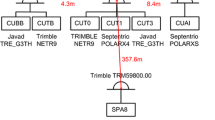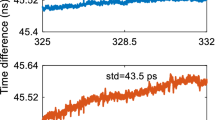Abstract
The loose integration positioning is typically applied for multi-frequency, multi-GNSS observations where the individual reference satellite is assigned for each system. BeiDou-3 navigation satellite system (BDS-3) broadcasts overlapping frequencies with other GNSS systems to enhance their interoperability, which allows us to set up the tight integration with a unique reference satellite for all systems with the same frequency. Although the unknown differential inter-system bias (DISB) parameters as the same number of increased observations are introduced epoch by epoch in tight integration, the stability of DISB can enhance the model strength and then improve the positioning performance. This paper intends to comprehensively study the tight integration to show its superiority for integer ambiguity resolution and precise positioning, compared to the loose integration. We first formulate the mathematical models for the loose and tight integrations, followed by the mathematical definition of DISB-float and –fixed tight integration models, respectively. The analysis of a two-day static datasets indicates the temporal stability of DISB and thus the feasibility of correcting DISB in tight integration. The static and kinematic positioning experiments show that the tight integration can significantly improve ambiguity resolution and positioning accuracy. Especially in harsh environments, with a given threshold of 3 for ratio-test, the ambiguity fix-rate is improved from 36.0 to 99.6% and from 13.1 to 26.6% and the positioning precision is improved by 98.8% and 31.3% for static and kinematic situations, respectively.














Similar content being viewed by others
References
CSNO (2018) BeiDou navigation satellite system open service performance standard (version 2.0)
Guo J, Li X, Li Z, Hu L, Yang G, Zhao C, Fairbairn D, Watson D, Ge M (2018) Multi-GNSS precise point positioning for precision agriculture. Precis Agric 19(5):895–911
Joubert N, Reid TGR, Noble F (2020) Developments in modern GNSS and its impact on autonomous vehicle architectures. 2020 IEEE Intelligent Vehicles Symposium (IV). IEEE: 2029–2036
Julien O, Alves P, Cannon ME, Zhang W (2003) A tightly coupled GPS/GALILEO integration for improved ambiguity resolution. In: Proceedings of ENC-GNSS 2003, Graz, Austria, pp 22–25
Leick A, Rapoport L, Tatarnikov D (2015) GPS satellite surveying, 4th edn. Wiley, New York
Li B, Li Z, Zhang Z, Tan Y (2017) ERTK: extra-wide-lane RTK of triple-frequency GNSS signals. J Geod 91(9):1031–1047
Li G, Geng J, Guo J, Zhou S, Lin S (2018) GPS+Galileo tightly combined RTK positioning for medium-to-long baselines based on partial ambiguity resolution. J Glob Position Syst 16(1):3
Li B, Zhang Z, Zang N, Wang S (2019) High-precision GNSS ocean positioning with BeiDou short-message communication. J Geod 93(2):125–139
Li B, Zhang Z, Miao W (2020) Improved precise positioning with BDS-3 quad-frequency signals. Satellite Navig 1(1):1–10
Liu W, Wu M, Zhang X, Wang W, Ke W, Zhu Z (2021) Single-epoch RTK performance assessment of tightly combined BDS-2 and newly complete BDS-3. Satellite Navig 2(1):1–17
Odijk D, Teunissen PJG, Huisman L (2012) First results of mixed GPS + GIOVE single-frequency RTK in Australia. J Spatial Sci 57:3–18
Odijk D, Teunissen PJG (2013) Estimation of differential inter-system biases between the overlapping frequencies of GPS, Galileo, BeiDou and QZSS. In: Proceedings of 4th international colloquium scientific and fundamental aspects of the Galileo program. Dec 4–6, Prague, Czech Republic
Paziewski J, Wielgosz P (2015) Accounting for Galileo-GPS intersystem biases in precise satellite positioning. J Geod 89(1):81–93
Paziewski J, Sieradzki R, Wielgosz P (2015) Selected properties of GPS and Galileo-IOV receiver intersystem biases in multi-GNSS data processing. Meas Sci Technol 9(26):95008
Verhagen S, Li B, Teunissen P (2013) Ps-LAMBDA: ambiguity success rate evaluation software for interferometric applications. Comput Geosci 54:361–376
Wu M, Liu W, Wang W, Zhang X (2019) Differential inter-system biases estimation and initial assessment of instantaneous tightly combined RTK with BDS-3, GPS, and Galileo. Remote Sens 11(12):1430
Yang Y, Lu M, Han C (2016) Some notes on interoperability of GNSS. Acta Geod Cartogr Sin 45(3):253–259
Yang Y, Gao W, Guo S, Mao Y, Yang Y (2019) Introduction to BeiDou-3 navigation satellite system. Navigation 66(1):7–18
Zhang W, Cannon ME, Julien O, Alves P (2003) Investigation of combined GPS/Galileo cascading ambiguity resolution schemes. ION GPS/GNSS-2003. Institute of Navigation, Portland, USA, pp 2599–2610
Acknowledgements
This work is supported by the National Natural Science Funds of China (41874030, 42074026), the Program of Shanghai Academic Research Leader (20XD1423800), the Innovation Program of Shanghai Municipal Education Commission (2021-01-07-00-07-E00095), the “Shuguang Program” supported by Shanghai Education Development Foundation and Shanghai Municipal Education Commission (20SG18) and the Scientific and Technological Innovation Plan from Shanghai Science and Technology Committee (20511103302, 20511103402 and 20511103702).
Author information
Authors and Affiliations
Corresponding author
Additional information
Publisher's Note
Springer Nature remains neutral with regard to jurisdictional claims in published maps and institutional affiliations.
Rights and permissions
About this article
Cite this article
Chen, G., Li, B., Zhang, Z. et al. Integer ambiguity resolution and precise positioning for tight integration of BDS-3, GPS, GALILEO, and QZSS overlapping frequencies signals. GPS Solut 26, 26 (2022). https://doi.org/10.1007/s10291-021-01203-1
Received:
Accepted:
Published:
DOI: https://doi.org/10.1007/s10291-021-01203-1




